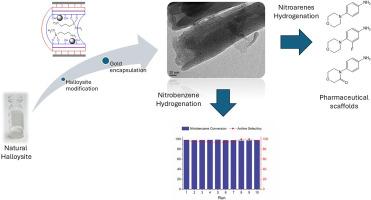有机改性高岭土纳米管作为金纳米颗粒的载体,作为高度可回收的硝基芳烃加氢催化剂
IF 5.4
3区 化学
Q1 CHEMISTRY, INORGANIC & NUCLEAR
引用次数: 0
摘要
采用胺-硅烷辅助法制备了有机改性高岭土纳米管(HNT)管腔,并包封金纳米粒子(Au- nps)作为硝基芳烃加氢催化剂。通过衰减全反射傅里叶变换红外光谱、zeta电位测量、- 196℃下N2吸附-解吸等温线、x射线衍射、紫外-可见漫反射光谱和透射电镜对所得材料进行了表征。Au-NPs均匀分布于HNT腔内。Au负载的增加(从0.10 wt%增加到0.50 wt%)导致Au- nps尺寸分布更广。在中等反应条件下(30°C, 10 bar H2压力在乙醇中)对催化剂进行了硝基苯加氢反应,评价了催化剂的性能和可重复使用性。结果表明,催化剂对Au-NPs尺寸在1.5 ~ 6.5 nm范围内的变化较为敏感。含有0.10 wt% Au的催化剂表现出优异的稳定性和可回收性,在至少10次连续重复使用循环中以最小的损失保持其催化活性。此外,最佳催化剂在药物基硝基芳烃加氢反应中表现出较高的效率和选择性。提出的有机改性HNT材料为合成高效和可重复使用的金属基催化剂提供了一条创新途径,在其他类似的催化过程中显示出巨大的潜力。本文章由计算机程序翻译,如有差异,请以英文原文为准。

Organo-modified halloysite nanotubes as supports for gold nanoparticles as highly recyclable catalyst for hydrogenation of nitroarenes
Organo-modified halloysite nanotube (HNT) lumens were synthesized via an amine-silane-assisted method to encapsulate Au nanoparticles (Au-NPs) as catalysts for hydrogenation of nitroarenes. The obtained materials were characterized by attenuated total reflectance Fourier-transform infrared spectroscopy, zeta potential measurements, N2 adsorption–desorption isotherms at −196 °C, X-ray diffraction, ultraviolet–visible diffuse reflectance spectroscopy, and transmission electron microscopy. The Au-NPs were uniformly distributed within the HNT lumen. An increase in Au loading (from 0.10 to 0.50 wt%) resulted in a broader Au-NPs size distribution. The catalysts were evaluated for nitrobenzene hydrogenation as test reaction under moderate reaction conditions (30 °C and 10 bar H2 pressure in ethanol) to assess their performance and reusability. Results indicate that the catalysts are sensitive to variations in the Au-NPs size in the range of 1.5–6.5 nm. The catalyst containing 0.10 wt% Au exhibited exceptional stability and recyclability, retaining its catalytic activity with minimal loss over at least 10 consecutive reuse cycles. In addition, the best catalyst displayed a high efficiency and selectivity in the hydrogenation of pharmaceutical-based nitroarenes. The proposed organo-modified HNT material offers an innovative route for synthesizing efficient and reusable metal-based catalysts demonstrating significant potential for their use in another similar catalytic processes.
求助全文
通过发布文献求助,成功后即可免费获取论文全文。
去求助
来源期刊

Inorganic Chemistry Communications
化学-无机化学与核化学
CiteScore
5.50
自引率
7.90%
发文量
1013
审稿时长
53 days
期刊介绍:
Launched in January 1998, Inorganic Chemistry Communications is an international journal dedicated to the rapid publication of short communications in the major areas of inorganic, organometallic and supramolecular chemistry. Topics include synthetic and reaction chemistry, kinetics and mechanisms of reactions, bioinorganic chemistry, photochemistry and the use of metal and organometallic compounds in stoichiometric and catalytic synthesis or organic compounds.
 求助内容:
求助内容: 应助结果提醒方式:
应助结果提醒方式:


